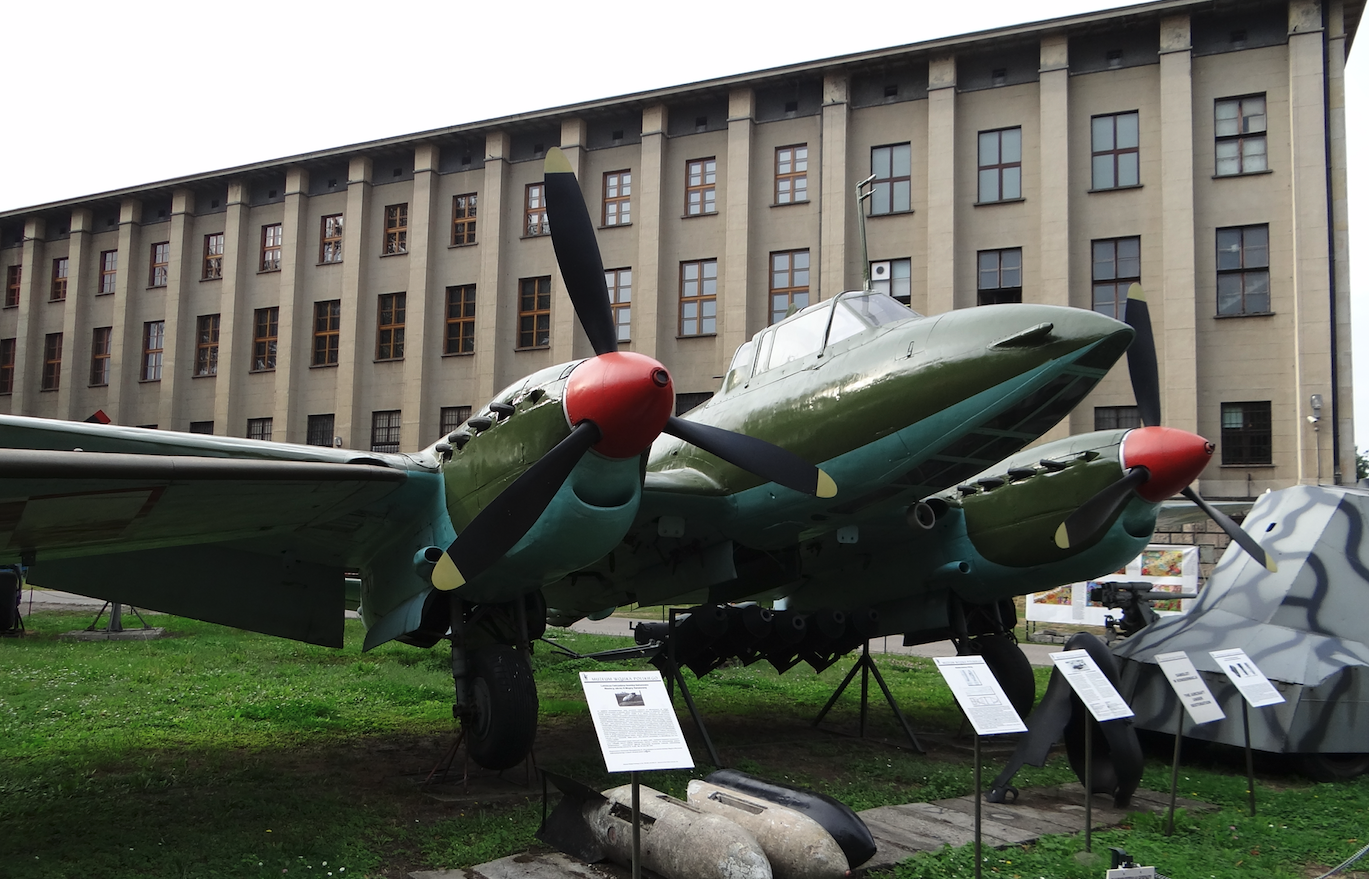Powidz 2007-12-16
7th Independent Dive Bomber Aviation Regiment.
7th Bomber Aviation Regiment.
7th Bomber-Reconnaissance Aviation Regiment.
Powidz. 22.01.1946 – 15.07.1999.
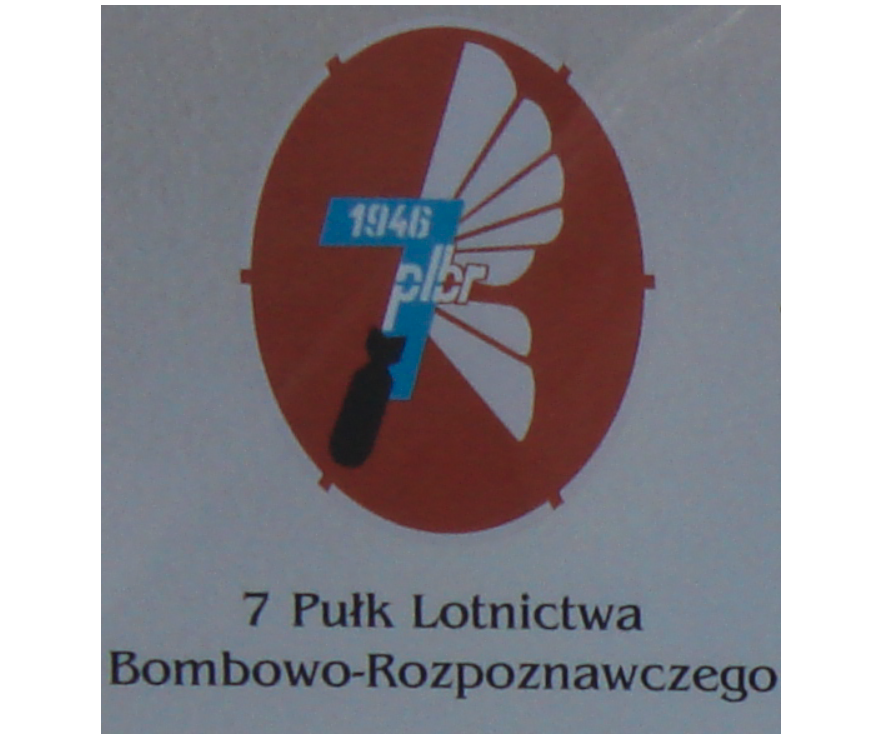
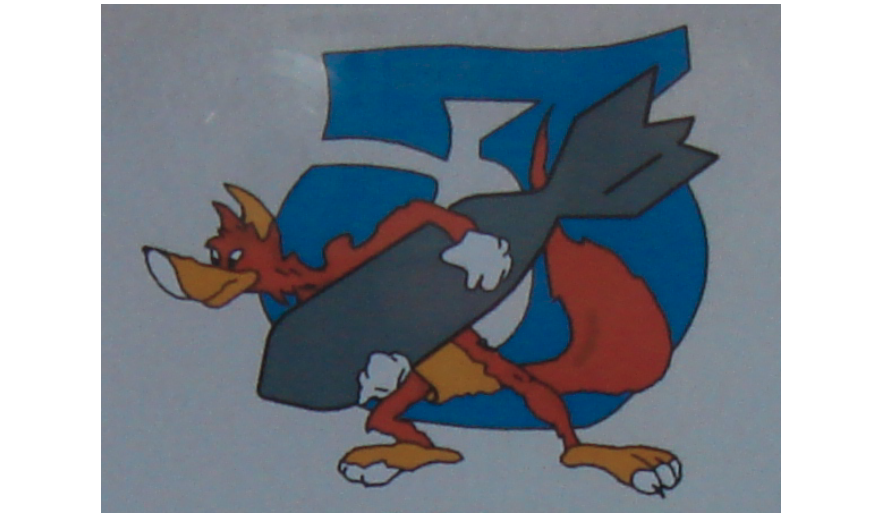
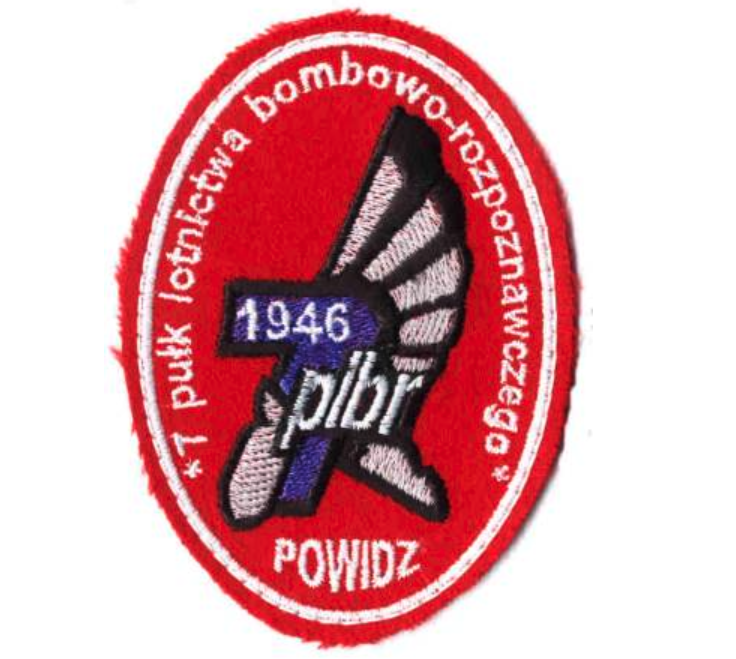
The 7th Regiment was a military unit that did not have its roots in the CCCP. The regiment was established on the basis of order No. 019 of January 22, 1946, of the Supreme Commander of the Polish Army and was given the name 7th Independent Diving Bomber Aviation Regiment. This happened during the first major reorganization of the Polish Army after World War II. Leźnica Wielka near Łęczyca was designated as the place where the new Regiment would be stationed. The first Polish commander was Major Pilot Szczepan Ścibior. In the initial period, the unit was transferred (re-based) many times. And so in turn; – Poznań-Ławica 12/04/1947-23/10/1950, – Malbork 24/10/1950-3/04/1952, – Bydgoszcz 4/04/1952-7/04/1953, – Warsaw-Bemowo 8/04/1953-7/10/1953, – Modlin 8/10/1953-3/07/1957, – Powidz 4/07/1957 – permanent until 15/07/1999, until reorganization.
Pe-2 in the 7th Independent Dive Bomber Aviation Regiment.
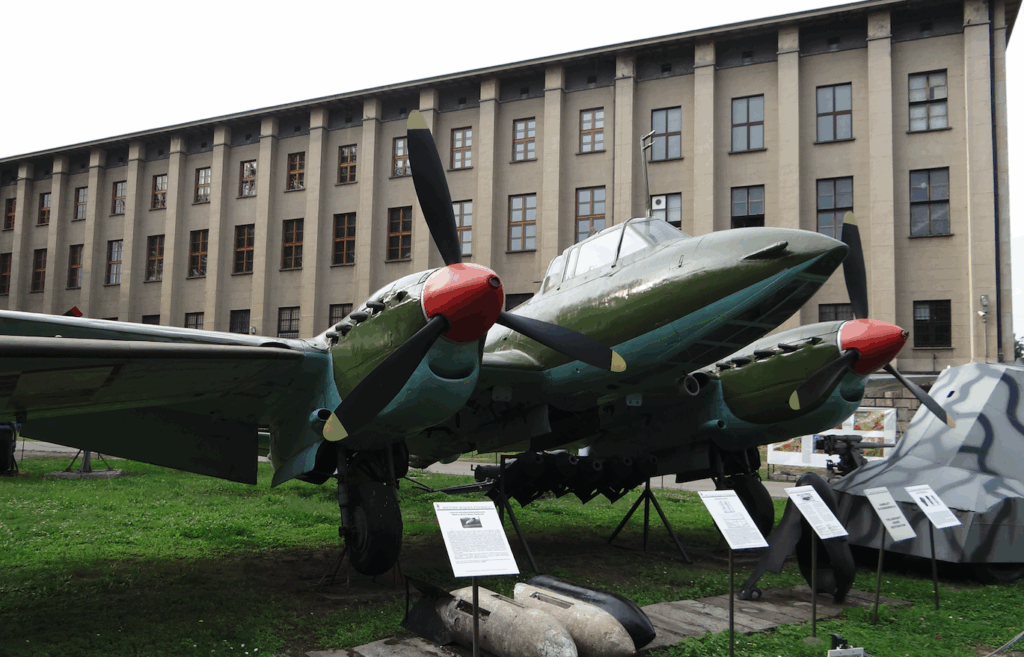
The first basic aircraft used by the 7th Regiment, for a period of over four years, was the Pe-2 dive bomber. These were aircraft produced during World War II. The Polish armament mainly included the Pe-2 FT version developed in 1942. On September 1, 1949, the 7th Regiment had in stock: – 40 Pe-2 aircraft, – 4 UPo-2 aircraft, – 9 Po-2 / CSS aircraft (Polish version of the Po-2).
Tu-2 in Polish Aviation.
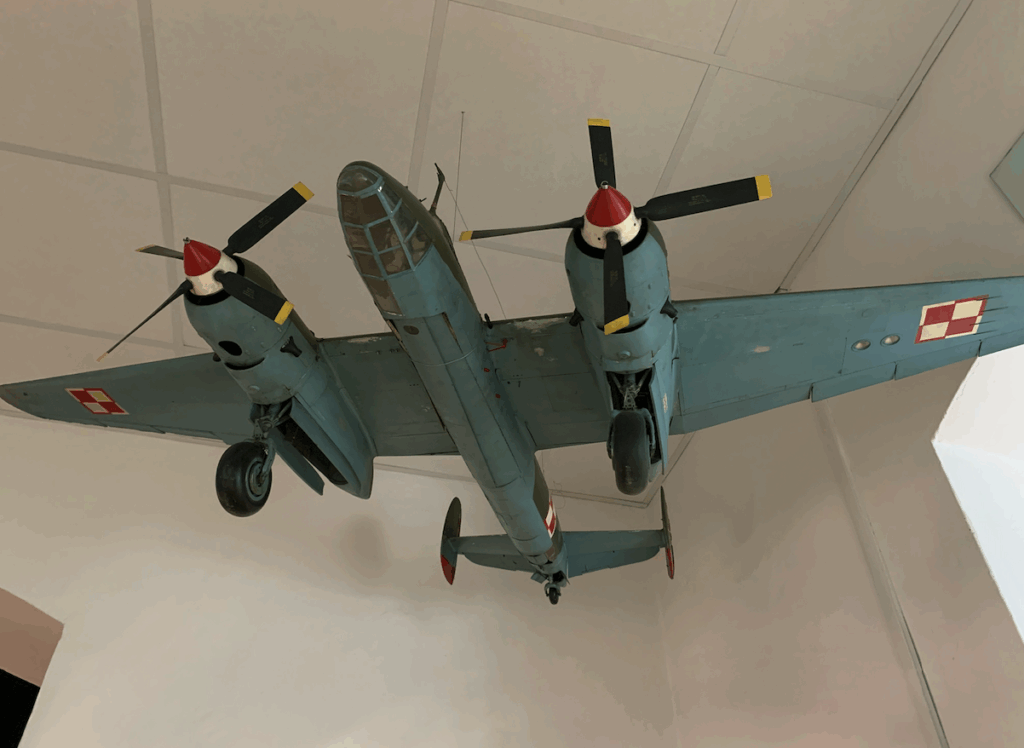
At the end of 1949, decisions were made to acquire new Tu-2 bomber aircraft for the armament of the only Polish Bomber Unit. It was, to be honest, an outdated design. As proof, its production ended in 1948, after 2,527 machines had been built.
The first Tu-2 bomber aircraft appeared in Poland in January 1950. The first to be trained were the management staff of the 7th PLB; the unit commander, his deputy for piloting, and squadron commanders and their deputies. At that time, another batch of Tu-2 aircraft was delivered, and a few weeks later, more machines. These aircraft allowed the 1st Squadron to be re-equipped from Pe-2 aircraft to Tu-2 aircraft.
The training was conducted on a specially adapted Tu-2 aircraft, equipped with two sets of controls. The pilot’s seat was occupied by a student, and the navigator’s seat by an instructor. A few months later, the unit received a transitional Sukhoi UTB-2 aircraft used to train piloting without the ground in sight and for night flights.
The new bombers were first shown over Warsaw during the May Day holiday on May 1, 1950. The air part of the parade at 10:20 was opened by a single Tu-2 aircraft piloted by Colonel Pilot Włodzimierz Gawryłow, escorted by two Yak-9P fighters. Next flew a formation of five Il-10 attack aircraft. Next came a formation of five Tu-2 bombers. During its flyover, the commentator reported that one of the aircraft was led by a newly trained crew consisting of: pilot Zygmunt Michnowski, navigator Gobis, gunner Hinc. A large group of Pe-2 bombers flew behind the Tu-2 bombers.
The Tu-2 bombers were once again shown to a wider audience at Okęcie on August 20, 1950, on the occasion of Aviation Day. This time, a flight of three aircraft gave an impressive demonstration of bombing a simulated target at the airport.
The Tu-2 aircraft was a medium bomber performing horizontal bombing thanks to precise sights. They were used for night flights with great success. Previous bombers, the Pe-2, attacked only from a diving flight and flew exclusively during the day. Since the Tu-2 had the greatest range in the Polish Army, they were successfully used in reconnaissance flights. These aircraft were also used by the Navy Aviation. The rearmament of the Polish Military Aviation with Tu-2 aircraft coincided with the introduction of turbojet aircraft to world aviation. Therefore, the Polish Military Command decided to stop the process of introducing more Tu-2 aircraft. Therefore, the bomber, reconnaissance and naval aviation had both types of bombers in their armament at the same time. The complete rearmament of these units took place after the introduction of modern Il-28 turbojet bombers. At that time, both the Pe-2 and Tu-2 were withdrawn from the front line. This happened in 1957.
In 1956, one Tu-2 was adapted for parachute jump training using a seat ejected using a gunpowder cartridge. The project of the aircraft modification was developed at the Air Force Institute of Technology. The actual modification took place at the Aircraft Repair Plants. The upper position of the gunner-radio operator (radio operator) was removed from the aircraft, installing an ejection seat in its place, the same as used in MiG-15/Lim-1 aircraft. The aircraft was used for training Air Force pilots. The aircraft was publicly demonstrated on August 26, 1956, at Okęcie during the Aviation Festival. From this aircraft flying at an altitude of 1,000 m, the test jumper Capt. Kazimierz Dulla shot off the seat, flying on it in a large arc outside the aircraft. Then the jumper separated from the seat and landed on a parachute. The seat also fell on its own parachute. This special aircraft was then demonstrated at the static exhibition at Okęcie until September 9, 1956. This aircraft was also demonstrated in August 1964, at the now inactive Czyżyny military airport. To this day (2007) only two Tu-2s used by Polish Aviation have survived. The first one, this special one, is in the Aviation Museum in Czyżyny and the second one is in the Polish Army Museum in Warsaw.
New Il-28 bombers.
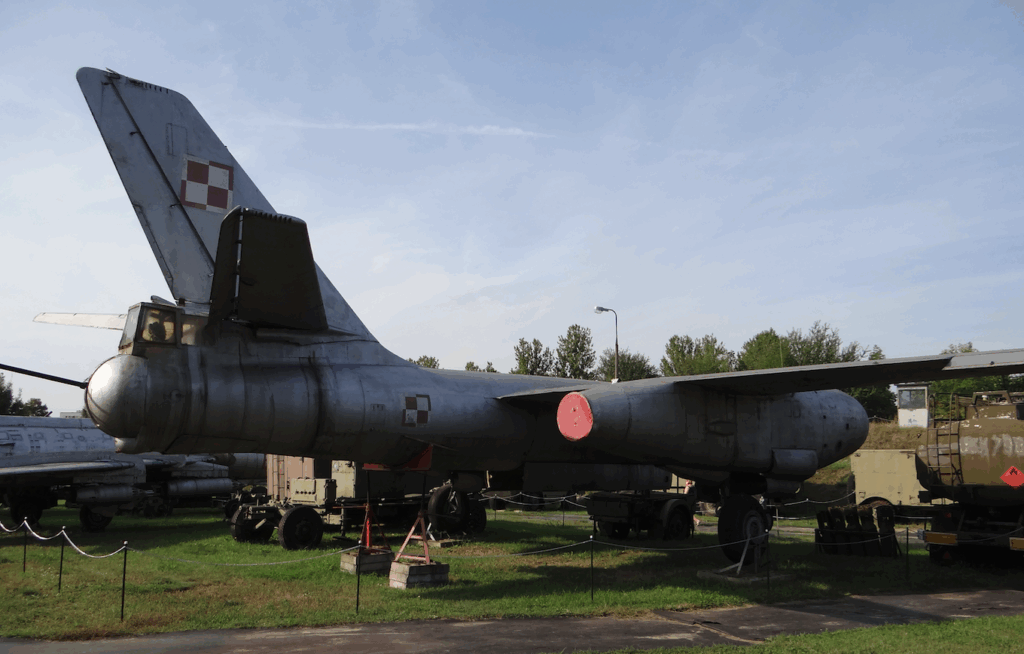
In February 1951, a modified “Plan of Organizational Intentions for the Years 1951-1952” was implemented, assuming, among other things, a dynamic quantitative growth of the Air Force, which was to form 25 air regiments from scratch. One of the points was the development of bomber aviation and the introduction of turbojet aircraft into service.
The legal basis for the implementation of the plan was the Directive No. 00020 issued by the Ministry of National Defense on February 21, 1951, on the basis of which the Order of the Ministry of National Defense No. 0036/Org. was developed. from 7 April 1951, ordering the Commander of the Air Force to form the 15th Bomber Aviation Division (Division) at the Malbork airport by 1 August 1951, consisting of the 7th and 33rd Bomber Aviation Regiment, the 68th Signal Company and the 48th Mobile Aviation Repair Workshops. The basic aircraft was to be the Tu-2 piston-engined bomber.
The choice of Malbork as a base was not accidental. In the realities of the time, it provided the most convenient position for conducting an attack in the north-west direction, which was in line with the Kremlin’s plans.
However, two bomber aviation regiments were not enough. The implementation of the “Plan of organizational intentions for the years 1951-1952” resulted in the development of the MON order no. 0096/Org of 11 December 1951, by virtue of which the Minister of National Defense ordered the Commander of the Air Force to introduce a new organization of the 15th Air Force Base, enlarged by the new 35th Bomber Aviation Regiment. The new regiment was to be formed by 1 December 1952, at the Inowrocław airport. The main executor of the order to form the 35th Air Force Base was the commander of the 15th Air Force Base.
At that time, a decision was made to purchase Il-28 turbojet bombers, which meant suspending deliveries of Tu-2s, as we wrote above. The division made initial preparations. The first analyses showed that Il-28 jets could only be used from airports of an appropriate standard. The Malbork airport did not meet these requirements, mainly due to the lack of a suitable concrete runway and taxiways.
In this situation, on 3–4 April 1952, the entire 15th DLB was redeployed to the new airport in Bydgoszcz. This airport had a concrete runway and taxiways. It was larger and had better facilities. It was perfectly suited to accepting a new type of bomber. Throughout 1952, the 15th DLB at the Bydgoszcz airport made intensive preparations to accept new technology in the form of Il-28 bombers. Bydgoszcz became the central base for rearming and retraining the bomber aviation.
The first public flight demonstration of the Il-28 bomber took place on July 20, 1952, on the occasion of the July 22 holiday, during a show at Okęcie airport. According to available information, it was a plane piloted by a Soviet crew of instructors who had come to train Polish Pilots.
In the autumn of 1952, theoretical training of the designated flight and technical personnel began. On October 31, 1952, the first batch of 8 Il-28 jet bombers landed at the Bydgoszcz airport. At the same time, a group of Soviet instructors was brought in from units based in the GDR and from the CCCP.
The planes were brand new. They were left in the color of natural duralumin. Checkerboards were applied to the vertical tail, the rear part of the fuselage and the wings. The side (side) numbers were painted according to Soviet standards. The planes received consecutive ordinal numbers, unrelated to the serial numbers. And so; 7 PLB – numbers from 1 to 20, 33 PLB – from 21 to 40, 35 PLM – (from 1954, when it began to accept Il-28 planes) from 40 to 60. Most importantly, the numbers were in different colors depending on the affiliation to a given regiment. And so; 7 PLB had side numbers in red, 33 PLB – in blue, 35 PLB – in dark yellow with a navy blue border. Anticipating the facts, I will point out that over the years, as aircraft were transferred to other units (21st SPLR – independent reconnaissance aviation regiment, 15th SELR MW – independent naval reconnaissance aviation squadron, OSL-4 in Dęblin, 19th LEH – towing aviation squadron), the principle of ordered numbers in squadrons was abandoned. For example, in 35th PLB, subsequent tactical numbers from the series “60”, “70” and “80” were introduced. UIł-28 training aircraft also received subsequent serial numbers preceded by the letter S, while Ił-28 R reconnaissance aircraft received subsequent serial numbers preceded by a zero. Of course, there were exceptions.
In order to ensure proper training of Polish personnel, on December 11, 1952, the first training and combat UIł-28 (factory number 64204) landed at the Bydgoszcz airport. In addition, another 6 combat Il-28s were delivered. In total, by the end of 1952, the 15th DLB had 14 combat Il-28s and 1 training UIl-28, and the 15th DLB consisted of three regiments; 7th PLB, 33rd PLB, 35th PLB.
Until the end of September 1952, the above-mentioned composition carried out the main task of forming and expanding the structures and personnel of the regiment. On October 1, 1952, the commander of the 35th PLB issued the first regimental order, in which we read: I order the redeployment of the 35th PLB in two flights from the Bydgoszcz airport junction to the Inowrocław airport junction. The date for the redeployment of the ground flights (railway and vehicle) was set for October 5, 1952. Lieutenant Józef Pomianowski was appointed commander of the railway flight. Second Lieutenant Jan Wojciechowski commanded the vehicle transport. In the combat flight, 9 aircraft were redeployed by air, including: seven Pe-2 FT bombers, one UPe-2 combat trainer and one Po-2 trainer. These documents show that the 35th PLB took over all the division’s piston bombers, while the modern Il-28s were taken over by the 7th PLB and the 33rd PLB. Along with the acceptance of the first Il-28 and UIl-28 jet aircraft by the 15th DLB units, another batch of piston aircraft was transferred from the 7th and 33rd PLB to the 35th PLB: three Tu-2s, three Pe-2 FTs, one UPe-2 and one Po-2. In this way, the account of the 35th PLB increased to 17 aircraft, including: 13 combat, 2 combat training and 2 training.
The location of the 35th PLB in Inowrocław was a deliberate solution. Although the airport only had a grassy take-off field, this did not interfere with the operation of piston bombers.
The beginning of 1953 was an intensive period of training on the new equipment. Training was carried out quickly and without major disruptions. More Il-28 aircraft arrived in Bydgoszcz. Pilots of the new bombers were usually pilots of Pe-2 or Tu-2 bombers. Interestingly, despite the completely different drive, retraining did not pose any major problems. Usually, after a few flights on the UIl-28 version, the pilot could fly solo.
The Air Force Command began to consider moving the 7th PLB to a permanent base in the north of the country, but after a MiG-15 bis aircraft was hijacked from Słupsk to the island of Bornholm (and two months later another MiG-15 bis), a decision was made to leave the modern Il-28s inland. The main forces of the 15th DLB in the form of the 7th PLB and the 33rd PLB were relocated on 8 April 1953, from Bydgoszcz to Warsaw (Bemowo). Bydgoszcz remained the central base of Il-28 bombers.
However, a few months later, a decision was made to redeploy the bomber units. The 35th PLB was relocated from Inowrocław to the airport in Przasnysz, and the 7th PLB and 33rd PLB from Bemowo to Modlin. Exactly half a year later, on October 8, 1953, both regiments were relocated to Modlin airport.
The year 1953 was characterized by very intensive training of all crews of the 15th DLB. This is evidenced by the number of flying hours. For example, the 35th PLB achieved an airborne flight time of 922.41 hours, including: on combat aircraft – 550.39 hours; on training and combat aircraft – 60.53 hours; on training aircraft – 311.09 hours.
1954
Throughout 1954, the Il-28 crews gathered at the Modlin airport continued training in daytime individual and group flights and bombing.
A decision was made in the spring of 1954 to make the first public display of the Il-28 in flight. This took place on July 22, 1954, during a parade over Katowice (at that time called Stalinogród). The parade was attended by crews from the 7th PLB and 33rd PLB in Il-28s. These aircraft were preceded by the commander of the 35th PLB, Major Pilot Kazimierz Wierzbicki in a Tu-2.
In mid-1954, it was time to train the last regiment of the 15th DLB, i.e. the 35th PLB, in the new Il-28 bombers. According to the order of the Commander of the WL in connection with the start of training for new equipment, the 35th PLB was to be relocated from Przasnysz to the Modlin airport on 20–22 May 1954. Since the regiment was to receive Il-28 jets in Modlin, the Pe-2 FTs in its possession were left at the Przasnysz airport and designated for scrapping. Two crews, who were at the training ground in Świdwin, flew Tu-2s (tact number 05, 08), which were handed over to the forming towing flight on 11 June 1954 (order of the Chief of the General Staff of the Polish Army no. 0138/Org.). Thus, only the three CSS-13 aircraft still in possession were relocated to Modlin by air.
By the end of May 1954, the 35th PLB personnel were preparing a barracks and training base at the Modlin airport. At the same time, the flight and technical personnel were selected and qualified for training on the Il-28 jets. Thus, all three Bomber Regiments constituting the 15th DLB were at the Modlin airport.
On June 6, 1954, the first two Il-28s were accepted into the 35th PLB, which were intensively used for theoretical training. On September 25, 1954, the first crew of the 35th PLB, under the command of Maj. Pilot Józef Ostrowski, performed an independent flight on the Il-28.
During the annual briefing in the division, the results of the competition were announced: 1st place 7th PLB, 2nd place 35th PLB, 3rd place 33rd PLB.
On 15.10.1954, the 7th PLB had: 27 aircraft of various types, including: 20 Il-28 bombers, 3 UIl-28 combat trainers and 4 CSS-13 trainers.
1955.
In mid-June 1955, the division commander received an order to present Il-28 aircraft for a parade over Warsaw on 22.07.1955. The Il-28 aircraft were to be demonstrated in three groups. The first group was to be presented by the 7th PLB (15 Il-28 aircraft), the second by the 33rd PLB, the third by the 35th PLB (9 Il-28 aircraft) together with the 21st SPLR (independent reconnaissance aviation regiment, 6 Il-28 aircraft). Initially, training was conducted in flight formations, and later in the entire bombing group.
The parade crews took off and landed at Modlin Airport, and the take-off order was as follows: 1. parade leader accompanied by two fighters, 2. column of aircraft led by Major A. Kwiatkowski, 3. column of aircraft led by Major J. Wójcik, 4. column of aircraft led by Major J. Ostrowski.
In the morning of July 22, 1955, the aircraft were lined up at the airport in the order they were to take off. The next crews took off systematically every 30 seconds, and after gathering in the air, they went to the designated route. On the first section: Modlin-Gąbin, the entire column of the division was formed, and after the turn at 6:00 PM, they returned to Modlin, where they performed a maneuver onto the combat route and from Nasielsk along the combat route to Warsaw. The flight over the honorary tribune took place according to plan. After flying over Warsaw, after a few minutes, a right turn over Otwock, where the column was disbanded, and over Modlin, the individual crews. The parade was a good test of the level of training of the division crews.
Another year ended with a high mark for the division. The competition repeated the order from the previous year. Additionally, the 7th PLB and 35th PLB ended the year without any accidents, which was a huge success.
In 1955, the Division was ordered to transfer 12 Il-28 aircraft, four from each Regiment, to the 21st Independent Reconnaissance Aviation Regiment in Sochaczew. The basic aircraft in this Regiment were 8 Il-28 R aircraft and one UIl-28. The 7th PLB transferred its 4 Il-28 aircraft to the 21st SPLR in May 1955.
1956.
In 1956, the Division received another delivery of nine Il-28s, which filled the gaps after the aircraft transferred to Sochaczew. The aircraft were distributed to each regiment in threes. On January 17, 1956, three Il-28s were added to the 7th PLB.
In May 1956, a delegation of the Czechoslovak Air Force arrived in Modlin, headed by its commander, deputy commander and advisor. The guests were introduced to the training base, purpose and tasks of the division.
At the end of June 1956, all regiments of the division were put on full combat alert, but this state was not maintained for long. This was due to the unrest and workers’ strike that occurred in Poznań (Poznań Uprising) and, as a consequence, the movements of the Red Army troops.
Powidz. 1957.
In 1957, the deliveries of Il-28 aircraft to Poland ended. In the period 1952-1957, we bought a total of; 73 Il-28, 16 UIl-28 (Il-28 U) and 9 Il-28 R.
Units in which Il-28 aircraft were operated; – 15 DLB (7 PLB, 33 PLB, 35 PLB) in Modlin, and later also Powidz, – OSL-4 in Dęblin; a few units for a short period (1953-1957), – 21 SPLR in Sochaczew; including 6 Il-28 R, – 15 SELR in Siemirowice; including 3 Il-28 R, – 19 EH (towing squadron) in Słupsk. With the arrival of 1957, at the meeting of the 35th PLB, the command read the organizational order of the Commander of the WL and OPL OK, in which the purpose of the regiment was changed from bomber to training and combat. That is, the regiment was named 35. PLSzk-B, and the 7th PLB and 33rd PLB remained typical bomber regiments. In June 1957, the division commander was tasked with preparing the assigned forces and resources for the air shows and parade on the occasion of Aviation Day. On July 4, 1957, the 7th PLB was relocated from Modlin to Powidz airport. Powidz became the permanent base for the 7th PLB. Powidz was designated as the airport of the parade group of the 15th DLB, with its new host, the 7th PLB. On 12–16 August 1957, the designated forces and assets of the 35 PLB were relocated to Powidz for parade training. The flight of a combat echelon of 10 crews + 2 spares took place on 16 August 1957, along the route: Modlin-Barłogi-Powidz. An interesting fact was that among the personnel designated for the parade there were six trained crews.
For three weeks, the personnel of the 15th DLB trained for the parade, initially in groups of five-plane wedges, and later in two groups, each with 25 Il-28s. The parade took place on September 8, 1957, over the Warsaw Bemowo (Babice) airport. The bomber aviation group was led by Colonel Dipl. Pilot Julian Paździor, accompanied by four fighter planes, piloted by PSP veterans in the West. The first group of bombers (a column of wedges – 25 Il-28s) was led by the commander Major Pilot Jerzy Wójcik. In this column, the first three wedges (15 Il-28s) came from the 7th PLB, the next two (10 Il-28s) were fielded by the 35th PLB. The second column was represented entirely by the 33rd PLB led by Major Pilot Jerzy Adamec.
After the parade, the 15th DLB personnel gathered at the Powidz airport were visited by the commander of the WL and OPL OK, Brig. Gen. pilot Jan Frey-Bielecki, who thanked all participants for the excellent performance of this difficult task.
Right after this parade, the division received another task to take part in shows and a parade over Łódź. However, on 14.09.1957, due to poor weather conditions, only a flight of bombers under the command of Major Józef Czernecki flew over Łódź. The flight took place along the route: Modlin-Łowicz-Zgierz-Łódź-Skierniewice-Modlin.
Another presentation of bomber aviation by crews from the 15th DLB was their participation in the September (1957) shows over the southern regions of Poland. On September 20, 1957, a flight of Il-28s commanded by Major J. Czernecki moved to Mierzęcice, from where on September 22, 1957, they flew over Kraków as part of a regional air parade and a little later over Katowice. This time, the flight route was as follows: Mierzęcice-Tarnowskie Góry-Kraków-Dąbrowa Górnicza-Katowice-Mikołów-Mierzęcice.
In early autumn 1957, 13 flying personnel arrived at the 7th PLB: 4 pilots, 3 navigators and 6 gunners-radiotelegraphers.
1958
In 1958, at the request of the Operational Aviation Command, the Ministry of National Defense management decided to disband the 35th Air Force Base, and the aircraft were ordered to be transferred to the 7th Air Force Base in Powidz and to the 33rd Air Force Base in Modlin.
1959
In 1959, a large air parade was organized once again on the occasion of the communist holiday. Il-28 bombers could not be missing. All units with these aircraft presented their bombers for the parade. On July 22, 1959, a large rhombus consisting of 16 Il-28 aircraft and a column of five rhombuses with 4 aircraft each were presented. A total of 36 Il-28s were shown in the air.
7th PLRO (Operational Reconnaissance Aviation Regiment) in Powidz. 1960. Il-28 E.
At the beginning of the 1960s, the Il-28s were no longer meeting the requirements for bombers and were assigned to reconnaissance tasks. Bomber units were transformed into reconnaissance regiments. Thus, the 7th PLB and 33rd PLB changed their names to operational reconnaissance aviation regiments, and the numbering remained unchanged. In the mid-1960s, electronic warfare equipment sets were purchased from the USSR and 10 Polish Il-28s were converted into EW aircraft designated Il-28 E. Each set was equipped with an SRS-2 or SRS-3 radio-technical reconnaissance station and an SPS-2 active electronic interference station or an ASO-28 cut metalized foil ejector (popularly known as a “chaff cutter”). The Il-28 E served in the 7th PLRO (operational reconnaissance aviation regiment) in Powidz. A successor to the Il-28 aircraft had been sought since the 1960s. The purchase of supersonic Yak-27s and later Yak-28s was considered, but more detailed analyses showed that they had no significant advantage over the Il-28. It was not until 1974 that the Polish Air Force received a successor to the Il-28. It was the Su-20 fighter-bomber.
In the 60s, the regiment changes its name from the 7th Operational Reconnaissance Aviation Regiment to the 7th Bomber-Reconnaissance Aviation Regiment.
In 1966, on the occasion of the 1000th Anniversary of the Polish State, 33 Il-28 aircraft formed the stylized “Eagle”.
Su-20 in the equipment of the 7th PLB-R. 1974.
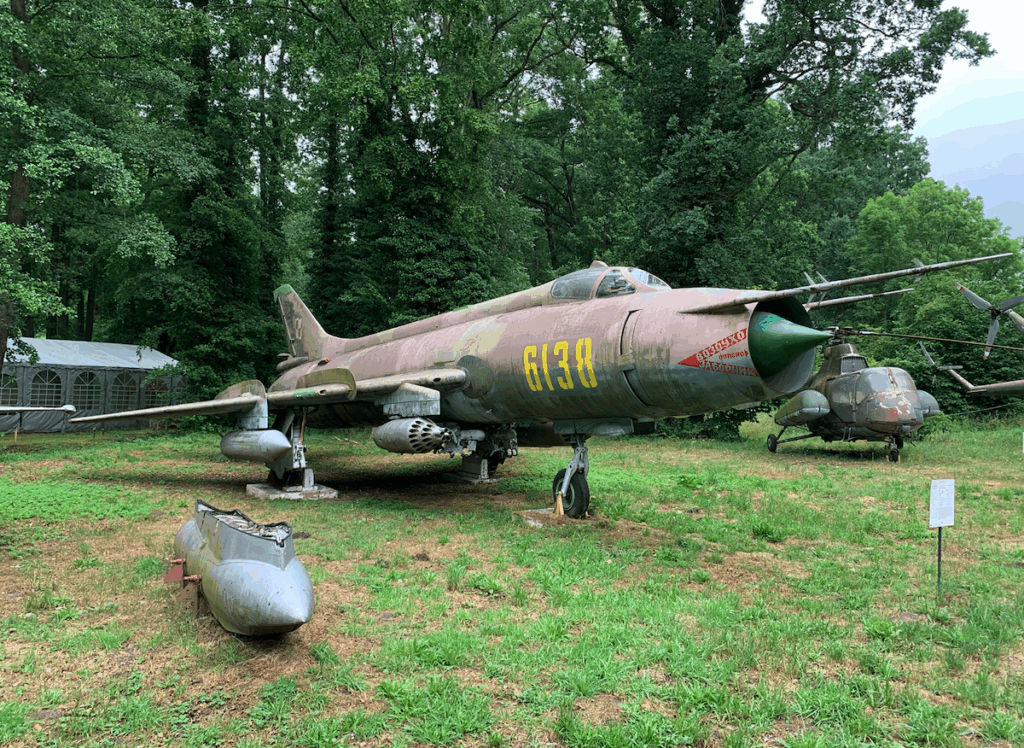
At the beginning of the 70s, the Il-28 bombers were already a very outdated type. In addition, there was no prospect of acquiring a new type of bomber aircraft. “Big Brother” offered only fighter-bomber aircraft.
In the first days of 1974, a group of pilots and technicians left for Krasnodar to train for a new type of aircraft. Among the pilots were Major Pilot Maciej Paszkowski – commander of the 7th Bomber-Reconnaissance Aviation Regiment from Powidz in 1974-1975, Second Lieutenant Pilot Bogdan Lis. They were the first to perform independent flights on the Su-20 in Krasnodar. Due to bad weather conditions, the training was prolonged. During this training, Capt. Pil died during a flight on the Su-20. Tadeusz Kołodziejczyk.
The first 6 Su-20s were delivered to Poland in 1974. On 26.04.1974 they landed at the airport in Powidz. These aircraft received side numbers from 01 to 06, painted red. Of course, they were shown to the public during the parade in Warsaw on 22.07.1974. We received the remaining aircraft only in 1976. A total of 25 were purchased. We did not buy the training-combat version, because the Su-7U was still used in this role.
Unfortunately, before the main delivery was completed on 3.02.1976, we lost the first Su-20 aircraft. A painful loss, because another pilot, Maj. (Capt.) pilot Jerzy Doliniec, died. The cause was a technical failure of the equipment. There was an engine failure and problems with the generators. Therefore, in place of the lost aircraft, the manufacturer delivered a new one (1977). We received the aircraft on 12.02.1977. It received the nb 7125.
We received the remaining 19 Su-20 aircraft in the summer of 1976. These aircraft received four-digit side numbers derived from the serial numbers, painted in red. At that time, the side numbers of the first 6 aircraft also changed.
In Poland, Su-20 aircraft became dual-purpose aircraft. On the one hand, they could effectively attack enemy objects in depth, on the other hand, conduct active photo and radio-electronic reconnaissance during the day and night. The latter using a KKR-1 type underslung pod. The pods reached Poland later. It should not be forgotten that the Su-20 used in Poland was also a potential carrier of tactical nuclear weapons. The aircraft took part in their first joint exercises in 1976, during the “Shield-76” maneuvers. Throughout their service in Poland, the Su-20 aircraft were also operated from DOL (airport road sections).
In the 80s, pilots risked their own lives to save Su-20 aircraft three times. On May 17, 1984, Captain Andrzej Pawul collided with a stork in mid-air. With his face injured by glass fragments and limited vision, he landed safely in Powidz. On September 4, 1985, Captain Krzysztof Ryniecki, after firing a heavy S-24 missile, the engine pumped up and stalled. Despite the low altitude, the pilot managed to restart the engine and land safely. In 1988, Major Pilot Krzysztof Krzysztoforski’s aircraft was hit by lightning. The engine stalled. The pilot restarted the engine and landed safely.
Information from October 16, 1990, from a demonstration of Su-20 and Su-22 aircraft for Swedish officers. Su-20s used in Poland have excellent landing parameters. The champion of short landings is Captain Bogdan Juczyk. Before touchdown, at a height of 2 m, the pilot releases the braking parachute. The measured landing distance is only 350 m! At that time, American tests of the F-15 S / MTD aircraft gave a result of 450 m without a braking parachute, and 380 m with the method used in Poland. The mass of the Su-20 approaching to land is 11,000 kg, and the F-15 S / MTD – 13,000 kg.
The end of the Su-20 service.
In the mid-90s, the number of machines began to decrease rapidly. The planes crumbled due to the end of the airframes’ service life. The end of service came in February 1997, when the last machines were transferred to Bydgoszcz for several months of maintenance (?), and then dismantled. The last planes were crossed out of the inventory in 1998.
Su-22 in the inventory of 7 PLB-R. 1984.
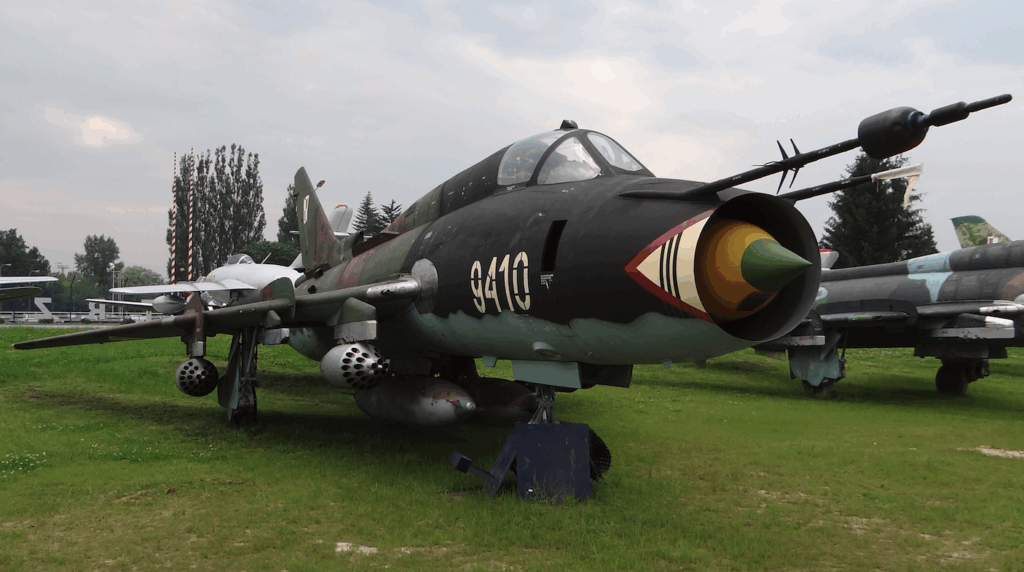
The next new versions of combat aircraft appeared in Powidz in 1984, in the form of fighter-bomber-reconnaissance Su-22 M 4 / Su-22 UM 3 K. This was due to the decision that the Regiment should be supplemented to three full Squadrons.
The Powidz airport was prepared to receive new aircraft. In the period August – October 1984, the first 13 aircraft were delivered to Powidz on board Il-76 and An-12/22 aircraft. These were 7 Su-22 M 4 machines (nb 3005, 3212, 3213, 3908-3911) and 6 Su-22 UM 3 K training and combat aircraft (104, 305-308, 509). All aircraft were part of the 6th PLM-B in Piła. In August 1985, the 40th PLM-B from Świdwin received its first Su-22, and in May 1986, the third squadron of the 7th PLB-R (bomber and reconnaissance aviation regiment) from Powidz (initially this squadron was to be part of the 8th PLM-B in Mirosławiec).
The delivered aircraft were brand new and in crates. They were assembled by the Soviets themselves and they also performed the flights. The Soviet factory group was headed by Alexander Kaczegarov. Only after the flights were the planes handed over to the Polish side. Captain Andrzej Rujner was responsible for the acceptance of the planes by the Polish Army, who had the power of attorney received from the Minister of Foreign Trade. The Soviets probably flew the first Polish Su-22 M 4 in Powidz on May 5, 1984. The technical life of Polish Su-22s in peacetime was 20-25 years.
Disbandment of the 7th PLB-R. 1999.
At the end of the 90s, the 7th PLB-R was disbanded. This was related to Poland’s accession to NATO and the transition to the system of Air Bases and Air Squadrons. Based on the order of the Minister of National Defense No. PF-74/Org of July 15, 1999 and the Order of the Chief of the General Staff of the Polish Army No. 083/Org of August 9, 1999, the 7th Tactical Air Squadron was established on the basis of the 7th PLB-R with a fighter-bomber profile and its assignment to the NATO Quick Reaction Forces.
Powidz Airport.
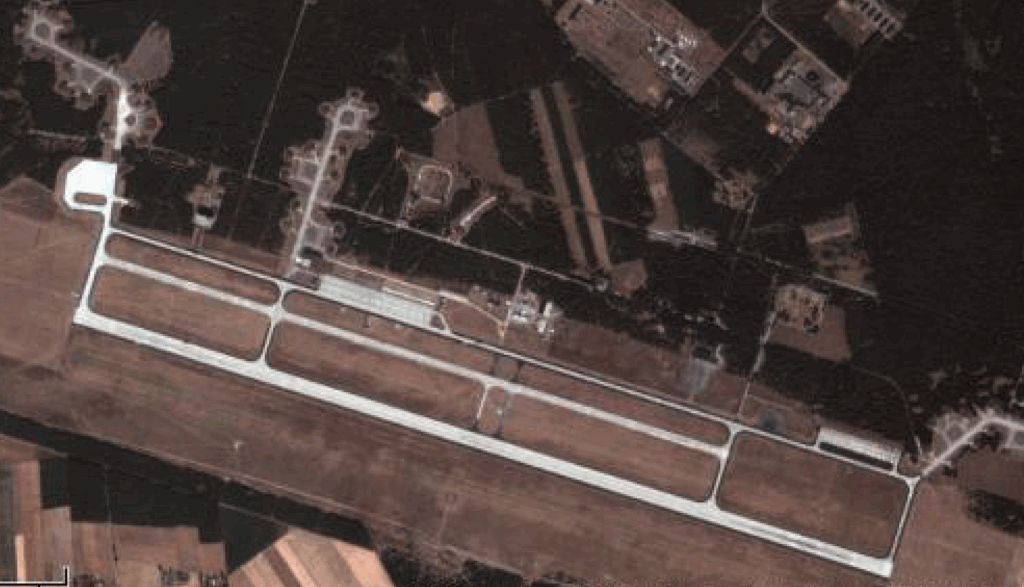
The Powidz Airport is one of the largest military airports in Poland. It has coordinates 52 22 N, 17 51 E and is located at an altitude of 113 m above sea level. It has two runways parallel to each other. The main runway measures 3,525 m x 60 m. It has an orientation of 11/29.
Written by Karol Placha Hetman

